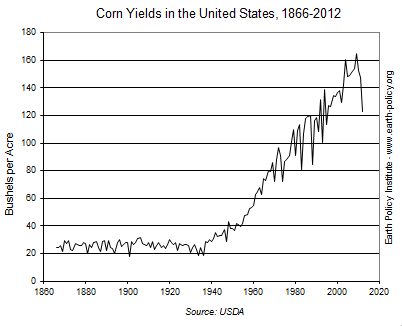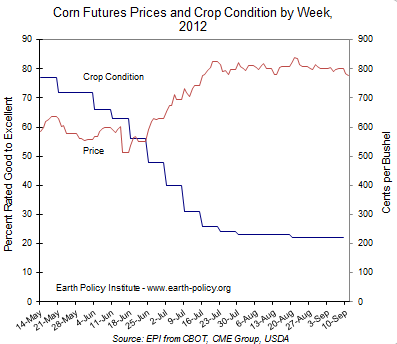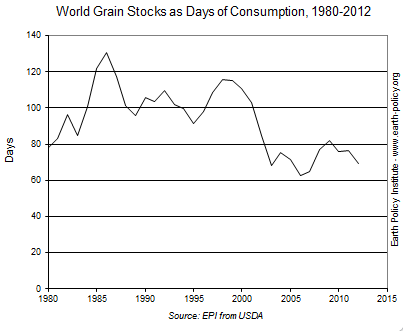By Janet Larsen
September estimates from the U.S. Department of Agriculture (USDA) show 2012 U.S. corn yields at 123 bushels per acre, down by a fourth from the 2009 high of 165 bushels per acre. Yields are the lowest since 1995 and well below the average of the last 30 years. The summer heat and drought also hit U.S. soybean yields, which are down 20 percent from their 2009 peak.

In the top corn-producing state of Iowa, the spring was nearly 9 degrees Fahrenheit warmer than the average over the last century. This was followed by an unusually warm and dry summer. St. Louis, Missouri, in the southern Corn Belt, suffered 11 days over 105 degrees Fahrenheit in the summer of 2012, more than ever before.
With soils desiccated by drought, the baking temperatures dried up corn silks and withered stalks. As summer progressed, more of the country’s corn crop slipped from “good” or “excellent” condition, as rated each week by USDA, to “fair,” “poor,” or “very poor.” Corn prices ratcheted up. On July 19th, the price of a bushel of corn on the futures market climbed above $8 for the first time ever. By that point in the summer, only 26 percent of the U.S. corn crop was in good shape, down from an estimated 77 percent early in the season.
This year has illustrated all too clearly the precarious relationship between temperature and yield. The “rule of thumb” is that each 1-degree-Celsius rise in temperature (1.8 degrees Fahrenheit) above the growing season optimum can cut productivity by 10 percent. Data from the field show that this may even be conservative. Once a high temperature threshold is crossed, plants cannot recover.
Crops in the United States are not the only ones to be hit this year; heat and drought are also hampering wheat production in Russia and Kazakhstan and corn production in southern Europe. Harvest shortfalls in both U.S. corn, which is by far the world’s largest crop, and wheat from the Black Sea region, which in a good year looms large among world exports, mean trouble. It is now almost certain that the world will fail yet again to bolster its carryover grain stocks, leaving us dangerously vulnerable to extreme weather in the coming years.
Carryover grain supplies in 2012 are projected to fall to 432 million tons, covering just 69 days of global consumption. With global warming making crop-damaging weather ever more likely, building a larger buffer of grain stocks—closer to 110 days of consumption—is more urgent than ever before.
For further reading on the global food situation, see Full Planet, Empty Plates: The New Geopolitics of Food Scarcity, by Lester R. Brown (W.W. Norton: October 2012). A free preview chapter of this soon-to-be-released book is online.





